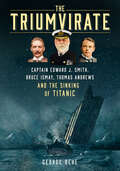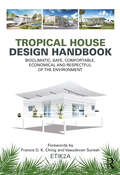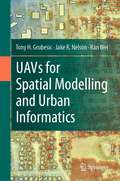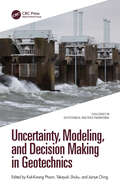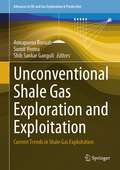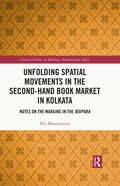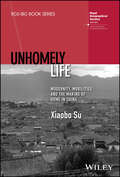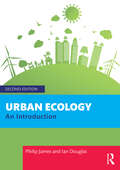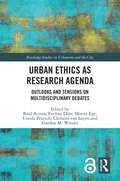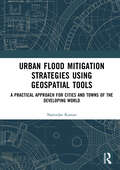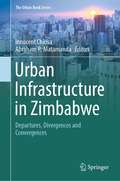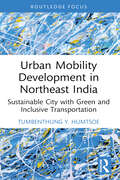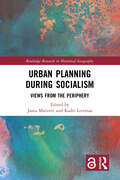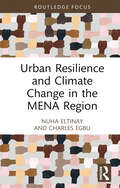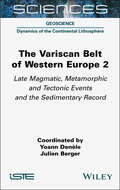- Table View
- List View
The Triumvirate: Captain Edward J. Smith, Bruce Ismay, Thomas Andrews And The Sinking Of Titanic
by George BeheTropical House Design Handbook: Bioclimatic, Safe, Comfortable, Economical and Respectful of the Environment
by Etik2aPacked with accessible information, this book covers all the technical and practical aspects of home design in tropical environments. . It begins by outlining the prerequisites needed to understand the issues involved (climate, heat, thermal comfort, etc.) and discusses the solutions offered by traditional housing. It then identifies current solutions for protecting buildings and their occupants from solar radiation and external heat, while promoting bioclimatic and environmentally friendly approaches. . The economic viability of the solutions identified is discussed, as are the advantages and disadvantages of the materials, depending on the context and standards in force. . Numerous examples illustrate how buildings can be adapted to local realities, from the avant-garde creations of Jean Prouvé to those of today’s architects who are committed to sustainable development, as well as specific projects incorporating the recommendations made in this book. More than 460 photos, drawings, diagrams, tables, maps, house plans, logos and pictograms illustrate this reference work for all those involved in construction in tropical regions, particularly students in the field and, more generally, anyone – from professionals to private individuals – looking for useful information on this subject.
Tropical House Design Handbook: Bioclimatic, Safe, Comfortable, Economical and Respectful of the Environment
by Etik2aPacked with accessible information, this book covers all the technical and practical aspects of home design in tropical environments. . It begins by outlining the prerequisites needed to understand the issues involved (climate, heat, thermal comfort, etc.) and discusses the solutions offered by traditional housing. It then identifies current solutions for protecting buildings and their occupants from solar radiation and external heat, while promoting bioclimatic and environmentally friendly approaches. . The economic viability of the solutions identified is discussed, as are the advantages and disadvantages of the materials, depending on the context and standards in force. . Numerous examples illustrate how buildings can be adapted to local realities, from the avant-garde creations of Jean Prouvé to those of today’s architects who are committed to sustainable development, as well as specific projects incorporating the recommendations made in this book. More than 460 photos, drawings, diagrams, tables, maps, house plans, logos and pictograms illustrate this reference work for all those involved in construction in tropical regions, particularly students in the field and, more generally, anyone – from professionals to private individuals – looking for useful information on this subject.
UAVs for Spatial Modelling and Urban Informatics
by Tony H. Grubesic Jake R. Nelson Ran WeiThis book aims to provide a wide range of real-world applications in using unmanned aerial vehicles (UAVs) for geographic observation, spatial modeling, and urban informatics. Specifically, UAVs are incredibly effective platforms for connecting people, places, and technology. This book explores the utility of UAVs for monitoring, measuring, and improving urban infrastructure systems, urban sustainability, and the urban environment. The dynamism of cities provides opportunities for economic, social, and environmental change, but benchmarking and measuring cities continues to be challenging. This challenge is due, at least in part, to a lack of monitoring systems that can collect and analyze data at a granular enough scale to capture the nuance of local phenomena. UAVs offer a promising mechanism to fill this niche, serving as a measurement platform that can rapidly and inexpensively collect data and monitor change in cities. However, their use is fraught with social, operational, regulatory, and technical challenges for successful deployments. This book provides a resource for urbanists (e.g., planners, geographers, sociologists, epidemiologists, engineers), educators, and students who work with geographic information and seek to enhance these data using data and information from unmanned aerial vehicles. At the same time, we provide operational and methodological frameworks for carrying out these advanced analyses in a manner that considers the challenges of incorporating UAVs in research within the urban environment. We provide six unique applications of UAVs for urban analysis, detailing relevant policy and empirical questions, UAV mission parameters, data collection, spatial modeling, and the associated empirical results. Further, we discuss how best to integrate these results into actionable geospatial intelligence and policy development to improve city infrastructure systems, sustainability, the environment, and neighborhood quality.
Uncertainty, Modeling, and Decision Making in Geotechnics
by Kok-Kwang Phoon, Takayuki Shuku, and Jianye ChingUncertainty, Modeling, and Decision Making in Geotechnics shows how uncertainty quantification and numerical modeling can complement each other to enhance decision-making in geotechnical practice, filling a critical gap in guiding practitioners to address uncertainties directly. The book helps practitioners acquire a working knowledge of geotechnical risk and reliability methods and guides them to use these methods wisely in conjunction with data and numerical modeling. In particular, it provides guidance on the selection of realistic statistics and a cost-effective, accessible method to address different design objectives, and for different problem settings, and illustrates the value of this to decision-making using realistic examples. Bringing together statistical characterization, reliability analysis, reliability-based design, probabilistic inverse analysis, and physical insights drawn from case studies, this reference guide from an international team of experts offers an excellent resource for state-of-the-practice uncertainty-informed geotechnical design for specialist practitioners and the research community.
Uncertainty, Modeling, and Decision Making in Geotechnics
Uncertainty, Modeling, and Decision Making in Geotechnics shows how uncertainty quantification and numerical modeling can complement each other to enhance decision-making in geotechnical practice, filling a critical gap in guiding practitioners to address uncertainties directly. The book helps practitioners acquire a working knowledge of geotechnical risk and reliability methods and guides them to use these methods wisely in conjunction with data and numerical modeling. In particular, it provides guidance on the selection of realistic statistics and a cost-effective, accessible method to address different design objectives, and for different problem settings, and illustrates the value of this to decision-making using realistic examples. Bringing together statistical characterization, reliability analysis, reliability-based design, probabilistic inverse analysis, and physical insights drawn from case studies, this reference guide from an international team of experts offers an excellent resource for state-of-the-practice uncertainty-informed geotechnical design for specialist practitioners and the research community.
Unconventional Shale Gas Exploration and Exploitation: Current Trends in Shale Gas Exploitation (Advances in Oil and Gas Exploration & Production)
by Annapurna Boruah Sumit Verma Shib Sankar GanguliFrom the geological mysteries of shale formations to cutting-edge techniques in gas extraction, this book unveils the essential knowledge to harness the potential of shale gas. The book integrates various data types such as outcrop, well logs, core data, etc.) for hydrofracturing—from basin-scale to nano-pore-scale. The book included a wealth of information on the latest advancements, industry practices, environmental considerations, policies, and more. In a world increasingly conscious of environmental concerns, "Cleaner Energy from the Earth" offers a fresh perspective on the utilization of shale gas as a cleaner fossil fuel alternative. This comprehensive book takes the reader on a captivating journey through the science, technology, and innovation driving shale gas exploration and exploitation towards a greener future. Whether you're a seasoned industry professional, a student, or a curious reader, this book provides a comprehensive and accessible resource for all levels of expertise.
Unfolding Spatial Movements in the Second-Hand Book Market in Kolkata: Notes on the Margins in the Boipara (Critical Studies in Heritage, Emotion and Affect)
by Diti BhattacharyaThis insightful book unfolds the boipara, exploring the acts of thinking and writing about space and place in the context of recent key conversations at the intersections of cultural geographies, mobilities, materialities and heritage studies. This book reconsiders how we can think about space, place and spatialisation using the book market as a case study. Focusing on everyday lived and imagined experiences within the space, it provides insights into the intricacies, complexities and mobilities involved in the many ways in which temporal, material, structural and sensorial experiences of spaces are inter-implicated. As expression and method, this work aims to be a writing of space (rather than a writing about space) produced through the interleafing of the author’s lived spatial experience of the boipara with the stories, experiences and memories of other regulars who have used and continue to use it, along with the non-human materialities and mobilities that characterise it. This book is essential reading for a wide international audience, particularly those interested in the evolving discussions on mobility, or writing about space and place, materiality, assemblage theory and heritage spaces in the South Asian context.
Unfolding Spatial Movements in the Second-Hand Book Market in Kolkata: Notes on the Margins in the Boipara (Critical Studies in Heritage, Emotion and Affect)
by Diti BhattacharyaThis insightful book unfolds the boipara, exploring the acts of thinking and writing about space and place in the context of recent key conversations at the intersections of cultural geographies, mobilities, materialities and heritage studies. This book reconsiders how we can think about space, place and spatialisation using the book market as a case study. Focusing on everyday lived and imagined experiences within the space, it provides insights into the intricacies, complexities and mobilities involved in the many ways in which temporal, material, structural and sensorial experiences of spaces are inter-implicated. As expression and method, this work aims to be a writing of space (rather than a writing about space) produced through the interleafing of the author’s lived spatial experience of the boipara with the stories, experiences and memories of other regulars who have used and continue to use it, along with the non-human materialities and mobilities that characterise it. This book is essential reading for a wide international audience, particularly those interested in the evolving discussions on mobility, or writing about space and place, materiality, assemblage theory and heritage spaces in the South Asian context.
Unhomely Life: Modernity, Mobilities and the Making of Home in China (RGS-IBG Book Series)
by Xiaobo SuHow do Chinas mobile individuals create a sense of home in a rapidly changing world? Unhomely life, different from houselessness, refers to a fluctuating condition between losing home feelings and the search for home — a prevalent condition in post-Mao China. The faster that Chinese society modernizes, the less individuals feel at home, and the more they yearn for a sense of home. This is the central paradox that Xiaobo Su explores: how mobile individuals—lifestyle migrants and retreat tourists from China's big cities, displaced natives and rural migrants in peripheral China—handle the loss of home and try to experience a homely way of life. In Unhomely Life, Xiaobo Su examines the subjective experiences of mobile individuals to better understand why they experience the loss of home feelings and how they search for home. Integrating extensive empirical data and a robust theoretical framework, the author presents a journey-based critical analysis of “home” under constant making, un-making, and re-making in post-Mao China. Su argues that the making of home is not a solely economic or rational calculation for maximum return, but rather a synthesis of resistance and compromise under the disappointing conditions of modernity. Offering rich insights into the continuity and disruption of China's great transformation, Unhomely Life: Develops an original theory of unhomely life that incorporates contemporary research and traditional Chinese ideas of home Explores the process of homemaking and its implications for understanding the costs of high-speed economic growth in China Analyzes mobile individuals across different genders, ages, ethnicities, social classes, and economic backgrounds to address the balance between meaning and money in everyday life Containing in-depth and sophisticated empirical data collected from 2002 to 2020, Unhomely Life: Modernity, Mobilities, and the Making of Home in China is an invaluable resource for advanced undergraduates, graduate students, lecturers, and academic researchers in cultural studies, migration, tourism, China studies, cultural anthropology, sociology, and social and cultural geography.
Unhomely Life: Modernity, Mobilities and the Making of Home in China (RGS-IBG Book Series)
by Xiaobo SuHow do Chinas mobile individuals create a sense of home in a rapidly changing world? Unhomely life, different from houselessness, refers to a fluctuating condition between losing home feelings and the search for home — a prevalent condition in post-Mao China. The faster that Chinese society modernizes, the less individuals feel at home, and the more they yearn for a sense of home. This is the central paradox that Xiaobo Su explores: how mobile individuals—lifestyle migrants and retreat tourists from China's big cities, displaced natives and rural migrants in peripheral China—handle the loss of home and try to experience a homely way of life. In Unhomely Life, Xiaobo Su examines the subjective experiences of mobile individuals to better understand why they experience the loss of home feelings and how they search for home. Integrating extensive empirical data and a robust theoretical framework, the author presents a journey-based critical analysis of “home” under constant making, un-making, and re-making in post-Mao China. Su argues that the making of home is not a solely economic or rational calculation for maximum return, but rather a synthesis of resistance and compromise under the disappointing conditions of modernity. Offering rich insights into the continuity and disruption of China's great transformation, Unhomely Life: Develops an original theory of unhomely life that incorporates contemporary research and traditional Chinese ideas of home Explores the process of homemaking and its implications for understanding the costs of high-speed economic growth in China Analyzes mobile individuals across different genders, ages, ethnicities, social classes, and economic backgrounds to address the balance between meaning and money in everyday life Containing in-depth and sophisticated empirical data collected from 2002 to 2020, Unhomely Life: Modernity, Mobilities, and the Making of Home in China is an invaluable resource for advanced undergraduates, graduate students, lecturers, and academic researchers in cultural studies, migration, tourism, China studies, cultural anthropology, sociology, and social and cultural geography.
Urban Ecology: An Introduction
by Philip James Ian DouglasThis fully revised second edition reflects the great expansion in urban ecology research, action, and teaching since 2015. Urban ecology provides an understanding of urban ecosystems and uses nature-based techniques to enhance habitats and alleviate poor environmental conditions. Already the home to the majority of the world’s people, urban areas continue to grow, causing ecological changes throughout the world. To help students of all professions caring for urban areas and the people, animals, and plants that live in them, the authors set out the environmental and ecological science of cities, linkages between urban nature and human health, urban food production in cities, and how we can value urban nature. The authors explore our responsibilities for urban nature and greening, ecological management techniques, and the use of nature-based solutions to achieve a better, more sustainable urban future and ensure that cities can climate change and become more beautiful and more sustainable places in which to live. This text provides the student and the practitioner with a critical scientific overview of urban ecology that will be a key source of data and ideas for studies and for sound urban management.
Urban Ecology: An Introduction
by Philip James Ian DouglasThis fully revised second edition reflects the great expansion in urban ecology research, action, and teaching since 2015. Urban ecology provides an understanding of urban ecosystems and uses nature-based techniques to enhance habitats and alleviate poor environmental conditions. Already the home to the majority of the world’s people, urban areas continue to grow, causing ecological changes throughout the world. To help students of all professions caring for urban areas and the people, animals, and plants that live in them, the authors set out the environmental and ecological science of cities, linkages between urban nature and human health, urban food production in cities, and how we can value urban nature. The authors explore our responsibilities for urban nature and greening, ecological management techniques, and the use of nature-based solutions to achieve a better, more sustainable urban future and ensure that cities can climate change and become more beautiful and more sustainable places in which to live. This text provides the student and the practitioner with a critical scientific overview of urban ecology that will be a key source of data and ideas for studies and for sound urban management.
Urban Ethics as Research Agenda: Outlooks and Tensions on Multidisciplinary Debates (Routledge Studies in Urbanism and the City)
by Raúl Acosta Eveline Dürr Moritz Ege Ursula Prutsch Clemens Van Loyen Gordon M. WinderThis book provides an outline for a multidisciplinary research agenda into urban ethics and offers insights into the various ways urban ethics can be configured. It explores practices and discourses through which individuals, collectives and institutions determine which developments and projects may be favourable for dwellers and visitors traversing cities. Urban Ethics as Research Agenda widens the lens to include other actors apart from powerful individuals or institutions, paying special attention to activists or civil society organizations that express concerns about collective life. The chapters provide fresh perspectives addressing the various scales that converge in the urban. The uniqueness of each city is, thus, enriched with global patterns of the urban. Local sociocultural characteristics coexist with global flows of ideas, goods and people. The focus on urban ethics sheds light on emerging spaces of human development and the ways in which ethical narratives are used to mobilize and contest them in terms of the good life. This timely book analyses urban ethical negotiations from social and cultural studies, particularly drawing on anthropology, geography, and history. This volume will be of interest to scholars, researchers and practitioners interested in ethics and urban studies.
Urban Ethics as Research Agenda: Outlooks and Tensions on Multidisciplinary Debates (Routledge Studies in Urbanism and the City)
This book provides an outline for a multidisciplinary research agenda into urban ethics and offers insights into the various ways urban ethics can be configured. It explores practices and discourses through which individuals, collectives and institutions determine which developments and projects may be favourable for dwellers and visitors traversing cities. Urban Ethics as Research Agenda widens the lens to include other actors apart from powerful individuals or institutions, paying special attention to activists or civil society organizations that express concerns about collective life. The chapters provide fresh perspectives addressing the various scales that converge in the urban. The uniqueness of each city is, thus, enriched with global patterns of the urban. Local sociocultural characteristics coexist with global flows of ideas, goods and people. The focus on urban ethics sheds light on emerging spaces of human development and the ways in which ethical narratives are used to mobilize and contest them in terms of the good life. This timely book analyses urban ethical negotiations from social and cultural studies, particularly drawing on anthropology, geography, and history. This volume will be of interest to scholars, researchers and practitioners interested in ethics and urban studies.
Urban Flood Mitigation Strategies Using Geo Spatial Tools: A Practical Approach for Cities and Towns of Developing World
by Narendar KumarThe disastrous effects of floods in urban areas of various Indian cities have been increasing in severity and extent over the past decade. This book explores flood disasters, their impact in world and Indian contexts, assessing vulnerability and risks involved, and systematic use of (GIS)-enabled platforms to map mitigation measures sustainably, with special reference to the metropolitan flood mitigation endeavors. This book balances the theoretical with empirical approaches to form a unique standpoint on the various challenges and possible solutions to urban flooding in India. Through a study of major urban flood incidents, this book analyzes the factors which contribute to the rising risk of flooding with increasing urbanization, population dynamics, growth, and urban sprawl, with particular focus on the cities of Chennai, Mumbai, and Hyderabad in India. It also examines disaster governance on urban floods and legislative prospects of flood disasters through discussions on standing acts, United Nations (UN) directives, and internationally adopted practices and actions, which are applicable in the Indian context. An interdisciplinary study, this book brings together tools and research from various disciplines including geography, urban and regional planning, and GIS. It will be an invaluable resource for researchers, scholars, engineers, students, planners, academicians, and professionals of cross-disciplines to help them resolve the problem of urban flooding. It will also be of interest to the general reader seeking to learn more about disasters, urban flooding, engineering, and GIS.
Urban Flood Mitigation Strategies Using Geo Spatial Tools: A Practical Approach for Cities and Towns of Developing World
by Narendar KumarThe disastrous effects of floods in urban areas of various Indian cities have been increasing in severity and extent over the past decade. This book explores flood disasters, their impact in world and Indian contexts, assessing vulnerability and risks involved, and systematic use of (GIS)-enabled platforms to map mitigation measures sustainably, with special reference to the metropolitan flood mitigation endeavors. This book balances the theoretical with empirical approaches to form a unique standpoint on the various challenges and possible solutions to urban flooding in India. Through a study of major urban flood incidents, this book analyzes the factors which contribute to the rising risk of flooding with increasing urbanization, population dynamics, growth, and urban sprawl, with particular focus on the cities of Chennai, Mumbai, and Hyderabad in India. It also examines disaster governance on urban floods and legislative prospects of flood disasters through discussions on standing acts, United Nations (UN) directives, and internationally adopted practices and actions, which are applicable in the Indian context. An interdisciplinary study, this book brings together tools and research from various disciplines including geography, urban and regional planning, and GIS. It will be an invaluable resource for researchers, scholars, engineers, students, planners, academicians, and professionals of cross-disciplines to help them resolve the problem of urban flooding. It will also be of interest to the general reader seeking to learn more about disasters, urban flooding, engineering, and GIS.
Urban Infrastructure in Zimbabwe: Departures, Divergences and Convergences (The Urban Book Series)
by Innocent Chirisa Abraham R. MatamandaThe book provides insights into urban infrastructure debates and discourses in Zimbabwe. Through an inter-disciplinary and multi-disciplinary approach, the book explores the theoretical, conceptual and lived experiences in urban infrastructure. The book focuses on case studies relating to urban transport, public housing, water and sanitation and Geographical Information Systems (GIS) among other substantive issues relating to urban infrastructure and services.
Urban Mobility Development in Northeast India: Sustainable City with Green and Inclusive Transportation (Routledge Contemporary South Asia Series)
by Tumbenthung Y. HumtsoeUrban Mobility Development in Northeast India theoretically and empirically explores the interrelationship between and among city, transportation, economic growth and environment to contribute towards engendering green urbanization for green growth.In a time of aggravating environmental crisis, the book recognizes the duality of contrasting impact of city and transport to economic development and environmental degradation. To serve as a guide for policy research, the book accessibly presents a contextual study blending qualitative as well as quantitative methodology in the context of a highland as well as a frontier capital city of the Northeastern Indian state of Nagaland, Kohima, towards creating a sustainable city with an inclusive and green mobility. The book underscores that management of urbanization and urban mobility challenges should go beyond supply side management and demand side management by democratizing policy making as well as considering efficiency, equity, welfare and practicality concerns and suchlike rationales.By traversing from abstraction to everyday life, from global context to frontier context and from macro level to micro level, the book makes significant theoretical as well as empirical contribution. The book will be of use to students, researchers, policy practitioners as well as general readers interested in Urban Studies, Transport Economics, Growth Economics, Development Studies, Environmental Studies and Asian Studies, especially in relation to highland and frontier regions in developing economies in general and Northeastern Region of India in particular.
Urban Mobility Development in Northeast India: Sustainable City with Green and Inclusive Transportation (Routledge Contemporary South Asia Series)
by Tumbenthung Y. HumtsoeUrban Mobility Development in Northeast India theoretically and empirically explores the interrelationship between and among city, transportation, economic growth and environment to contribute towards engendering green urbanization for green growth.In a time of aggravating environmental crisis, the book recognizes the duality of contrasting impact of city and transport to economic development and environmental degradation. To serve as a guide for policy research, the book accessibly presents a contextual study blending qualitative as well as quantitative methodology in the context of a highland as well as a frontier capital city of the Northeastern Indian state of Nagaland, Kohima, towards creating a sustainable city with an inclusive and green mobility. The book underscores that management of urbanization and urban mobility challenges should go beyond supply side management and demand side management by democratizing policy making as well as considering efficiency, equity, welfare and practicality concerns and suchlike rationales.By traversing from abstraction to everyday life, from global context to frontier context and from macro level to micro level, the book makes significant theoretical as well as empirical contribution. The book will be of use to students, researchers, policy practitioners as well as general readers interested in Urban Studies, Transport Economics, Growth Economics, Development Studies, Environmental Studies and Asian Studies, especially in relation to highland and frontier regions in developing economies in general and Northeastern Region of India in particular.
Urban Planning During Socialism: Views from the Periphery (Routledge Research in Historical Geography)
by Jasna Mariotti Kadri LeetmaaUrban Planning During Socialism delves into the evolution of cities during the period of state socialism of the 20th century, summarizing the urban and architectural studies that trace their transformations. The book focuses primarily on the periphery of the socialist world, both spatially and in terms of scholarly thinking. The case study cities presented in this book draw on cultural and material studies to demonstrate diverse and novel concepts of ‘periphery’ through transformations of socialist cityscapes rather than homogenous views on cities during the period of state socialism of the 20th century. In doing so the book explores the transversalities of political, economic, and social phenomena; the places for everyday life in socialist cities; the role of professional communities on production and reproduction of space and ecological thinking. This book is aimed at scholarly readership, in particular scholars in architecture, urban planning, and human geography, as well as undergraduate, graduate, and post-graduate students in these disciplines studying the urban transformation of cities after World War II in socialist countries. It will also be of interest for planning officials, architects, policymakers and activists in former socialist countries.
Urban Planning During Socialism: Views from the Periphery (Routledge Research in Historical Geography)
by Jasna Mariotti Kadri LeetmaaUrban Planning During Socialism delves into the evolution of cities during the period of state socialism of the 20th century, summarizing the urban and architectural studies that trace their transformations. The book focuses primarily on the periphery of the socialist world, both spatially and in terms of scholarly thinking. The case study cities presented in this book draw on cultural and material studies to demonstrate diverse and novel concepts of ‘periphery’ through transformations of socialist cityscapes rather than homogenous views on cities during the period of state socialism of the 20th century. In doing so the book explores the transversalities of political, economic, and social phenomena; the places for everyday life in socialist cities; the role of professional communities on production and reproduction of space and ecological thinking. This book is aimed at scholarly readership, in particular scholars in architecture, urban planning, and human geography, as well as undergraduate, graduate, and post-graduate students in these disciplines studying the urban transformation of cities after World War II in socialist countries. It will also be of interest for planning officials, architects, policymakers and activists in former socialist countries.
Urban Resilience and Climate Change in the MENA Region (Routledge Focus on Environment and Sustainability)
by Nuha Eltinay Charles EgbuThis book provides an overview of the geopolitical context and climate change risk profile of the Middle East and North Africa (MENA) Region. Mapping existing scientific literature and key reports on MENA climate change impacts and future projections, Nuha Eltinay and Charles Egbu establish links between the Conference of the Parties (from COP26, COP27 to COP28) Glasgow–Sharm el-Sheikh Work Program for Progress on the Global Goal on Adaptation, and regional climate adaptation financing targets, national government investments, and human security in local case studies. They also address gaps in disaster risk reduction institutional governance for sustainable development in the region. The authors move beyond the existing theoretical understanding of urban resilience to investigate how it is being measured and assessed in MENA in alignment with the IPCC’s climate change adaptation indicators. Finally, they explore how disasters and conflict displacement vulnerabilities and fragility affecting the communities most in need are being measured and integrated into cities’ resilience action plans and national disaster risk policies. Providing guidance and policy recommendations based on empirical research and key stakeholder engagement observations, this book will be of great interest to students, scholars, and professionals who are researching and working in the areas of climate change, urban planning, and environmental policy and governance. As this book comes out just after the closure of The United Nations Climate Change Conference COP28 negotiations, it sets the scene for pre-COP regional context, and paves the way for researchers and practitioners to undertake post-COP28 key takeaways and multi-level government commitments into action, for better climate mitigation and adaptation investments, resilient and sustainable future for all.
Urban Resilience and Climate Change in the MENA Region (Routledge Focus on Environment and Sustainability)
by Nuha Eltinay Charles EgbuThis book provides an overview of the geopolitical context and climate change risk profile of the Middle East and North Africa (MENA) Region. Mapping existing scientific literature and key reports on MENA climate change impacts and future projections, Nuha Eltinay and Charles Egbu establish links between the Conference of the Parties (from COP26, COP27 to COP28) Glasgow–Sharm el-Sheikh Work Program for Progress on the Global Goal on Adaptation, and regional climate adaptation financing targets, national government investments, and human security in local case studies. They also address gaps in disaster risk reduction institutional governance for sustainable development in the region. The authors move beyond the existing theoretical understanding of urban resilience to investigate how it is being measured and assessed in MENA in alignment with the IPCC’s climate change adaptation indicators. Finally, they explore how disasters and conflict displacement vulnerabilities and fragility affecting the communities most in need are being measured and integrated into cities’ resilience action plans and national disaster risk policies. Providing guidance and policy recommendations based on empirical research and key stakeholder engagement observations, this book will be of great interest to students, scholars, and professionals who are researching and working in the areas of climate change, urban planning, and environmental policy and governance. As this book comes out just after the closure of The United Nations Climate Change Conference COP28 negotiations, it sets the scene for pre-COP regional context, and paves the way for researchers and practitioners to undertake post-COP28 key takeaways and multi-level government commitments into action, for better climate mitigation and adaptation investments, resilient and sustainable future for all.
The Variscan Belt of Western Europe, Volume 2: Late Magmatic, Metamorphic and Tectonic Events and the Sedimentary Record
by Yoann Denele Julien BergerThis book deals with the geological record and the evolution of ideas concerning the Variscan orogenic belt in France and neighboring regions. Volume 1 is based on a general introduction concerning the imprint of the Variscan period on the geology of France, as well as on the particularities of the study of this ancient orogen. A history of the concepts applied to the Variscan belt is proposed in order to consider this orogen in the history of Earth Sciences. A paleogeodynamic analysis of the Variscan cycle sets the general framework for the evolution of the orogen, which is then tackled through the prism of the magmatic, metamorphic and tectonic record of the early phases (from Cambrian to Lower Carboniferous). Volume 2 proposes an analysis of the late evolution of the Variscan orogenic belt, reflecting its dismantling in a high-temperature context during the Upper Carboniferous and Permian. The sedimentary archives are described, as well as the questions raised by the specificities of this ancient orogen.
